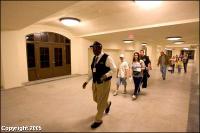 By Jim Schlosser
By Jim SchlosserNews-Record.com - Greensboro, North Carolina
It was as if the big clock in the concourse of Greensboro's old train station had been turned back to 1945.
A black cab, made to look like an old-fashioned London taxi and owned by the O. Henry Hotel, pulled up Friday in front of the columned station entrance on East Washington Street to deposit New York lawyer Martha Verscaj.
"I hate to fly," she said as she rolled her luggage through the big double doors.
School buses chugged in from Stokes County with 40 children from Sandy Ridge Elementary School eager to board a train to Raleigh. A teacher assistant, Karen Fulk, said the students are going to Raleigh to visit several museums.
"It would have been nice to have had this station last year," she said, recalling catching the train at Amtrak's one-room station in Pomona Yard. "We had to stand outside and wait for the train."
No longer. For the first time since the station closed in 1979, passenger train service is back at The Depot in downtown Greensboro.
On Friday, the enormous concourse, with three giant light fixtures hanging from the vaulted ceiling, was crowded. People stood while others were seated on the long wood benches that were there from 1927 to 1979 as passengers took the Southern Railway or Amtrak. Still others lined up at the wood ticket counter.
A voice sounded over the loudspeaker announcing the impending arrival of train No. 80, better known as the Carolinian, which runs from Charlotte to New York City. The voice from the speaker echoed off the high ceilings as it did years before.
When it opened 78 years ago, the train station was the biggest and finest in North Carolina. And it is again now that it has reopened as the J. Douglas Galyon Depot., a transportation center for buses and trains. Local, regional and long-distant Greyhound buses began operating last year out of the station's old baggage rooms and the former Railway Express Agency building.
 Some work at the station remains.
Some work at the station remains.The elevators and escalators that have been added to take passengers under the tracks and up to where the trains are boarded aren't working yet, but they should be within a week. The walls of the tunnel are bare. The wood benches that lined the space in the old days will return soon, some will be originals and others reproductions.
The area between the two train platforms -- one for the Raleigh-bound trains, the other for nighttime trains running from New Orleans to New York as Amtrak's Crescent -- looks swampy. Station attendant Jimmy Whitley said it will be landscaped with grass and flowers.
"There are some things to be completed," he said. "We are working around them."
The Carolinian arrived from Charlotte a few minutes late, pulling six cars. More than 100 passengers lined up to board, including Sally DAugustins and Sabrina Baumer.
They had driven from near Morganton to take the train to Washington, a city DAugustins has never visited. Her friend, Baumer, a German, has just completed a year studying in America and will return home in two weeks. Germany is a nation of passenger trains, but she said she has never ridden an intercity train there. This would be her first real train ride.
"We always go by car," she said.
As the train prepared to roll from the station, conductor Jack Hunt yelled from the rear car: "I love it. It's a great station. This is one of the best ones around, I can tell you."
Earlier, the Piedmont, a train going from Raleigh to Charlotte, pulled in almost on time, its brakes screeching loud enough to make hands go over ears.
With the book "The Bridges" in hand, Mary Ann Wyatt, of Greensboro, was headed for her granddaughter's christening in Charlotte.
"It's cheaper to ride a train than to pay for the gas to drive to Charlotte," she said.
She loves the station and is glad she no longer has to go to the freight yard, where Amtrak operated a one-room station from 1979 until last week.
A conductor up the tracks yelled "board," a shortened version of "all aboard," and the train hurried off.
James Fahlsted, of Greensboro, was there to see both trains depart. He was supposed to be fixing office machines elsewhere, but he often sneaks off to The Depot.
He was a regular at the Pomona station and, before it closed, the now-reopened downtown station.
He used to join a crowd of train buffs who would come in the middle of the night to watch the northbound and southbound Crescent arrive and depart.
"I just love trains," he said.
Fahlsted makes himself useful. He starts down the concourse, lecturing school groups on the history of the station. He then goes up to the loading platforms to help passenger and to make sure everyone doesn't get too near the edge.
How can you tell that Greensboro's station is many cuts above others?
"Check out the columns," Fahlsted said. "If a depot has no columns, it's a jerkwater town."
He explains that if it does have columns the station is important, but to determine how important, one must know his columns.
If the columns are Ionic style, it means the station is nice but not among the most important.
If the columns are Doric style, it's an important station.
If they are Corinthian, it means the station is a terminal, an ending point, such as Grand Central in New York City and Union Station in Washington.
Greensboro's station, he said, has Doric columns, which means "this is a major city.''
No comments:
Post a Comment